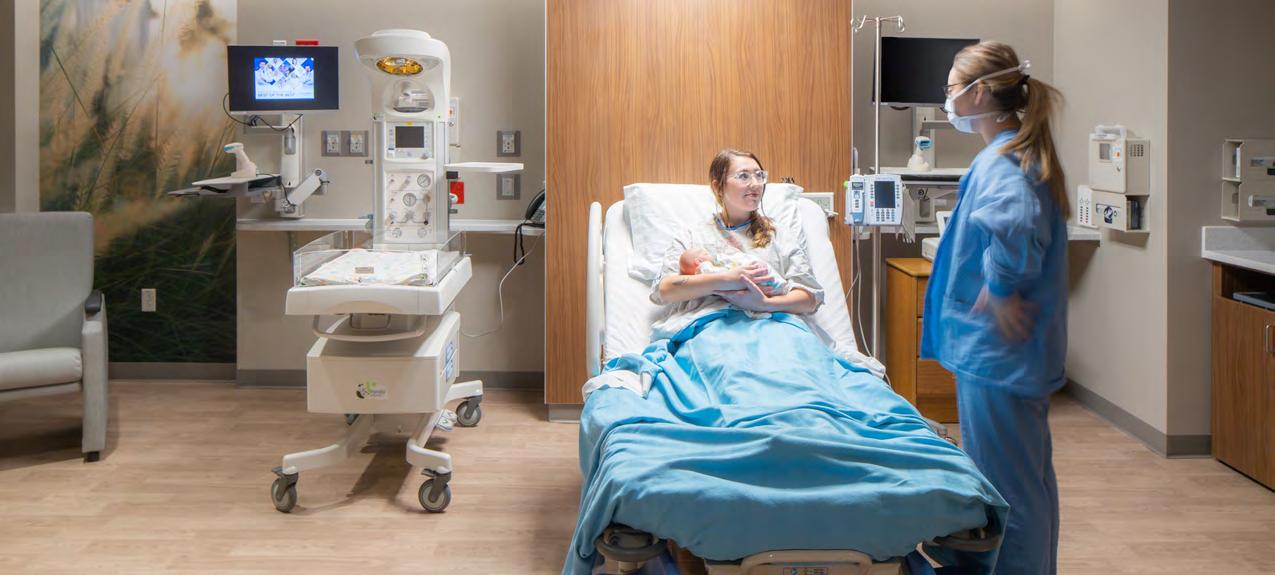
13 minute read
BEHAVIORIAL HEALTH Facing a Psychiatric Bed Crisis
Facing a Psychiatric Bed Crisis
When demand exceeds supply
Advertisement
TODD ARCHBOLD, LSW, MBA
As the world is resetting in the hopeful light of recovery from the pandemic, the fragile state of the mental health of our populations is increasingly apparent. We’ve endured the devastation suffered from the loss of life from COVID-19, economic tail spinning, political divide, and the fatigue of quarantine. While the situation is improving by the day, its impact on mental health will be lasting. There is a mental health crisis in our communities, and among health care workers. A new paradigm with more flexible care and equalizing disparities must arise and it will take a united and concerted effort to fulfill.
The state of psychiatric healthcare in Minnesota
There are over 1 million people in Minnesota experiencing symptoms of a mental illness today, which translates to almost one out of every 5 of us. The most common conditions are anxiety and depression, both of which have been greatly exacerbated by the impact of the pandemic. It is estimated that less than half of these individuals will ever seek help for their symptoms. Nearly 285,000 Minnesotan’s are currently struggling with a serious mental illness, resulting in substantial functional impairment and interference with major life activities (such as school or work). Our current “mental health system” is a collage of state operated, non-profit, and private providers offering often high-quality, but fragmented levels of care. Minnesota is home to some nationally recognized providers of health care ranging from Mayo Clinic and Allina Health to specialized behavioral health providers like Hazelden Betty Ford, PrairieCare, and The Emily Program. Collective efforts to improve population mental health in the past few decades have been largely focused on effective community-based services such as targeted case management, day treatment, school-linked services and mobile response.
Inpatient psychiatric bed capacity across the nation has shrunk by over 90% since the 1950s through the movement of “deinstitutionalization”, moving many individuals with severe mental illnesses to emergency rooms, jails or the streets. There are nearly three times more individuals with a serious mental illness in jail or prison, than in treatment facilities. ERs have become the most common entry point for a psychiatric crisis, and on average it takes 3.5 days for a hospital bed to become available, and often much longer for children and adolescents. There are currently 202 psychiatric hospital beds for youth and 590 adult beds in Minnesota, not including state run facilities. These meager capacities are reduced even further by a shortage of staff. Minnesota ranks 50 out of all states on having the fewest number of psychiatric beds per capita (3.5 beds per 100,000). The recommendation by health policy experts is 40-60 mental health beds for every 100,000. Most psychiatric units are at max capacity, most of the time – especially child and adolescent units. Minnesota has a moratorium on hospital beds, which requires an arduous and costly review process that ultimately requires legislative approval to add new licensed beds. This has prevented some systems from responding to this crisis. The state recently adopted the national model for Psychiatric Residential Treatment Facilities (PRTF), yet most commercial insurance companies have excluded PRTF care in contracts, creating access barriers and endless stress for patients and families.
The availability of psychiatric hospital beds in Minnesota is so limited, that the Department of Human Services and Minnesota Hospital Association created an online tool to help providers find available psychiatric beds across the state in real-time. Most often psychiatric beds are classified simply by age range; however, the term “psychiatric bed” is a misnomer as the care required for patients in crisis varies greatly. A psychiatric episode of care may vary from short-term stabilization, to several weeks of evaluation and complex medical support. Regardless, many days the bed finder tool will show that there are zero beds available. No other area of acute health care requires a bed finder – what does this tell us about the way we are responding to psychiatric needs in the state?
Exceptional Personalized Neurologic Care
Burnsville
952.435.8516
Coon Rapids
763.427.8320
Edina
952.920.7200
Golden Valley
763.588.0661
Maple Grove
763.302.4114
Outreach Clinics
throughout MN & western WI
For directions or additional information about the Minneapolis Clinic of Neurology Visit us online at www.minneapolisclinic.com
A look at what is broken
The main barriers we face in maintaining psychiatric inpatient units are not hard to understand. Why do we see ongoing expansion of birthing units, cardiology, and orthopedics, but not psychiatry? The data clearly suggests the need for psychiatric services, and the mortality rates of severe
mental illnesses easily outweigh the need for expansion in every other area of medicine – so why is there no investment in psychiatry?
Most large hospital systems across the country report that it costs more to provide inpatient psychiatric services than is covered by health plans. The patient care pathways are also much harder to predict. Consider this: and will be at high-risk of relapse and recurrence the rest of his life. The hospital and the health plans also know what to expect in this case – and neither like it. In the case of the appendicitis, a highly coordinated surgical team will perform the procedure in about an hour, and the patient will recover over the course of 2-3 weeks. The hospital could perform upwards of 180 appendectomies per year with the same care team, same OR, and a single hospital room. In the case of the substance abuse and
A 23-year-old male presents to an emergency Minnesota ranks 50 out of all psychosis, very few specialized care teams exist, and room with stabbing pain in the abdomen. states on having the fewest there is not single hospital procedure to remedy the The patient is quickly diagnosed with acute number of psychiatric condition. The over-medicalization of psychiatric appendicitis through imaging and routine labs. beds per capita. conditions overshadows emotional distress. The Physicians quickly determine evidenced-based initial phases of treatment may require a hospital bed care path, and the condition is aptly treated with for 2-3 weeks, and plethora of mental health staff an appendectomy and will discharge from the monitoring the patient 24/7. The reimbursement for hospital in 1-2 days. Both the hospital staff and the an entire week of observation may be similar to the insurance company know what their investment single appendectomy procedure that took place in just a portion of a single day. will be, and the likely outcome as benchmarked by hundreds of thousands of similar cases. There is a systemic ignorance of lack of parity in mental health care, and many fail to recognize this injustice. It is commonly known that reimbursement
The same patient a year later, now 24-years old, presents to an emergency for mental health services is at least 20% less than the rest of health care. room addicted to painkillers and is in a state of psychosis. There are no definitive This leads to lower staff wages and a lack of investment in infrastructure and labs or tests to diagnose the frightening condition, the medical history is complex, innovation. This outright disparity in payments stifles growth and has the and there are likely no psychiatrists available. Emergency room staff doesn’t know what to do. This patient will not be compliant with psychiatric treatment and state of mental health care services at least 20 years behind the advancements will likely need several weeks of intense stabilization, many months of treatment, Facing a Psychiatric Bed Crisis to page 164
Three patients. Who is at risk for diabetes?
1 in 3 adults are at risk!
When there are no signs or symptoms, you may not know until it’s too late. Act now. Screen your patients for type 2 diabetes. It’s easy. It’s covered. It will reduce their risk.
• Refer your at-risk patients to a proven lifestyle change program and help cut their risk of developing type 2 diabetes in half. • For patients who already have diabetes, send them to a quality diabetes self-management program to improve control and reduce complications. Find groups in Minnesota at
www.health.mn.gov/diabetes/programs
Minnesota Department of Health
DIABETES PROGRAM
3Facing a Psychiatric Bed Crisis from page 15
In the instance of psychiatric crisis, nearly 70% of patients in Minnesota will require a transfer from an emergency room that lacks capacity, to another throughout the rest of health care. The annual investment in mental health facility that may be hundreds of miles away. These transfers are costly and research is an abysmal 4% of total health research funding, despite the fact can create additional trauma. Psychiatric units within large health systems that some studies have shown the ongoing costs can become disenfranchised as they often compete to treat behavioral health conditions contribute to for resources and funding with more profitable nearly 45% of total health care spending. At the departments. In the current climate, it remains the end of 2020, a monumental lawsuit found one of onus of the few health systems that already offer the nation’s most profitable insurance companies psychiatric care to be the catalyst for change. Those was intentionally and methodically denying coverage for psychiatric services. The investigation revealed denials for care led to kids right here in It costs more to provide inpatient psychiatric services than is covered by health plans. who are already invested in psychiatric health care are bearing the weight of change, absorbing the pressure from other hospital systems to care for their Minnesota dying as a result of an identified, but sick patients in crisis. This can oftentimes lead to untreated mental illness. tension between hospital staff who are simply try to help their patients.
Health plans and employers have astutely developed wellness programs designed to combat How we transform psychiatric healthcare chronic health conditions such as obesity, diabetes, cardiovascular disease and We have opportunities to improve our system and become more solutionmore. Members are incentivized to eat well, track daily steps, and are even given oriented. We must address staffing and cost issues while including a much allowances for in-home gym equipment. These plans work remarkably well deeper investment into prevention and early identification. We must and have many overlapping benefits for mental health. However, individuals consider things such as: with serious mental illnesses often lack the resources, information or employer- • Integrated mental health services throughout all areas of medicine. connected health plan to engage and benefit from these types of plans. There Imagine psychologists and counselors prevalent in every trauma unit, appears to be little, if any, investment in engaging in these individuals. birthing center, pediatric clinic, and GI clinic.
Standalone behavioral health facilities have proven successful but lack true • More therapists in schools, and tools to screen for depression and anxiety health system integration and can have innate barriers to accessing services. in students – along with deeper education in wellness and resiliency.

Switching their model of care to better meet the needs of patients, Sanford Medical Center’s Family Birth Center in Bismarck, North Dakota provides a comforting atmosphere for families to welcome their most precious little additions. EAPC. NET/HEALTHCARE
• Streamlined access to mental health providers to truly build a continuum-of-care, not fragmented and siloed specialists. Regional disparities will always exist, and telehealth is our best tool to even the playing field.
The nation needs more training programs for psychiatrists, and we need to create jobs in the mental health field that pay better. Medical students early in their career are easily swayed towards much more lucrative careers in medicine such as surgery, interventional radiology, cardiology, urology, and others. We can also benefit from creating more opportunities for innovation, ranging from research to technology. Mental health care is lagging behind in this area, and we need to invest in the field to make it more exciting for workers and effective for patients. We also need to develop a more diverse workforce that can represent and tailor to the cultural needs of our patients. While the prevalence of psychiatric conditions across racial and ethnic groups is similar, studies show that minority groups are 50% less likely to access care because of these differences.
We need to invest in a fully integrated and balanced continuum of mental health services that includes telehealth. In order to effectively reduce the demand, we need to focus more resources on prevention and early identification in primary care, schools, and even among employers. The goal is to prevent crisis and reduce hospitalizations. All health care systems and providers have a responsibility to respond to mental health needs of patients. This requires more training in mental health, including identification of symptoms, crisis management, and providing basic care to those experiencing symptoms. Hospitals can benefit from specialized patient care spaces that decrease stimulation to provide a calming atmosphere, mitigate ligature risks, and have telehealth capabilities for quick access to specialists. These approaches will also reduce the tendency to medicalize complex psychological problems and distress.
Small psychiatric units embedded within large health systems can be tough to manage as they lack the capacity for diverse psychiatric specialization required for individual needs, and suffer from a lack of economies of scale. They can be financially subject to pro rata share of system costs and resources that are typically not required for psychiatric care (i.e. imaging, labs, ORs). In contrast, large standalone systems can struggle due to a lack of general health integration and access to necessary medical care resources. Rather, an integrated health system or collaborative partnerships that balances adequate psychiatric capacity and diverse mental health resources within a broader health system has countless benefits. Opportunities to share staff and offer two-way consultation within an integrated system lead to increased staff engagement and retention, and ultimately better patient experiences. This will reduce wait times and the inevitable need for stressful and costly transfer between facilities.
The case for why we need to transform psychiatric healthcare is simple – it requires a transformation. Our current systems are not sustainable or nearly as effective as they could be. Thousands of individuals suffer from mental illness and don’t have access to the care they need. This increases the morbidity and mortality of chronic health conditions, and this will not improve on its own. We must be the agents for change.
Todd Archbold, LSW, MBA, is a licensed social worker and the Chief Executive Officer at PrairieCare.




OFFICE OF MEDICAL CANNABIS

(651) 201-5598: Metro (844) 879-3381: Non-metro P.O. Box 64882, St. Paul, MN 55164-0882 health.cannabis@state.mn.us V Alzheimer’s is now an approved condition V
HAVE YOU REGISTERED WITH THE MINNESOTA MEDICAL CANNABIS PROGRAM?
Registration can be done online; there is no fee and it takes only a few minutes. Visit the registry website: mn.gov/medicalcannabis
Your account will provide access to medical cannabis purchasing information from patients you certify. Once you are registered, you will be able to certify patients with a variety of conditions, including:
• Cancer, Glaucoma, Tourette
Syndrome, HIV/AIDS, and ALS • Seizures, including those characteristic of Epilepsy • Severe and persistent muscle spasms, including those characteristic of MS • Obstructive sleep apnea • Alzheimer’s • Inflammatory bowel disease, including Crohn’s disease • Terminal illness, with a probable life expectancy of less than one year • Intractable Pain • Post-Traumatic Stress Disorder
• Autism
Cannabis Patient Centers are now open to approved patients in Minneapolis, Eagan, Rochester, St. Cloud, Moorhead, Bloomington, Hibbing, and St. Paul.
Many patients have reported improvement in their health status from medical cannabis — some describing dramatic improvements. Smoking cannabis is not allowed under the program. Visit our website for educational resources about cannabinoids and the endocannabinoid system and for scientific literature on the efficacy of medical cannabis in treating certain conditions. See our website for a detailed first year report.







